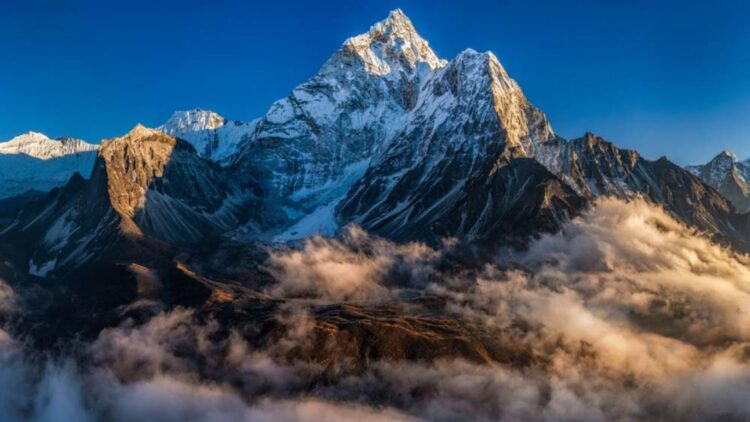World
Geologists Confirm Himalayas Splitting, Raising Earthquake Concerns

Recent research has revealed that the Himalayas are undergoing significant geological changes, as the Indian Plate beneath Tibet is splitting apart. This phenomenon raises concerns about potential earthquakes in the region, which has long been perceived as a stable and majestic mountain range.
To understand this development, it is essential to look back approximately 60 million years when the Indian Plate, then an island, collided with the Eurasian Plate. This collision led to the formation of the Himalayas, the tallest mountain range in the world. While the mountains appear unchanging, ongoing geological activity beneath the surface tells a different story.
According to a study by geologist Dan Klemperer and his team, the Indian Plate is not merely sliding horizontally beneath Tibet, as previously thought. Instead, the research indicates that it is splitting into two distinct layers. The upper layer continues its horizontal movement, while the denser lower layer is delaminating, meaning it is separating and sinking into the Earth’s mantle. This conclusion was reached through the analysis of seismic waves and the presence of specific isotopes in natural springs.
Understanding the Geological Processes
The study highlights the presence of helium-3 in over 200 natural springs, an isotope whose origin can only be traced back to the Earth’s mantle. This finding is significant as it supports the theory of delamination. Additionally, seismic data from the Honda seismic network has provided images of underground blocks, further confirming the changes occurring within the Indian Plate.
Seismologist Anne Meltzer from Lehigh University emphasizes the importance of understanding these geological processes. She states, “Almost all of Earth’s landmasses were built from a series of collisions like the Himalayas. Therefore, understanding how continents collide sheds light not only on our modern landscape but also on the hazards posed by earthquakes that may occur along the ancient scars of continental collisions.”
The research also sheds light on the Cona-Sangri Rift, a fault that is indicative of tectonic fracturing in the area. Although there is currently no direct evidence linking these geological changes to imminent seismic activity, the possibility remains. Geologists are concerned that the continuous tearing and movement of the Indian Plate could lead to increased earthquake activity in the future.
Implications for Earthquake Risk
The implications of these findings are significant. The Himalayas not only influence local ecosystems and weather patterns but also pose a risk to millions of people living in the surrounding regions. As the plate continues to shift, the potential for earthquakes increases, raising questions about preparedness and response in these vulnerable areas.
Researchers are calling for further studies to monitor the situation closely. Understanding the dynamics of the Indian Plate is critical for assessing the risks and preparing for any future seismic events. As scientists continue to investigate these geological processes, the information gathered will be vital for both local communities and policymakers.
In summary, the Himalayas are not as stable as they seem. The ongoing geological activity beneath the surface indicates a complex and evolving landscape that could have significant consequences for the future. As research progresses, the focus will remain on the potential for earthquakes and the broader implications for the region.
-

 Lifestyle5 months ago
Lifestyle5 months agoLibraries Challenge Rising E-Book Costs Amid Growing Demand
-

 Sports4 months ago
Sports4 months agoTyreek Hill Responds to Tua Tagovailoa’s Comments on Team Dynamics
-

 Sports4 months ago
Sports4 months agoLiverpool Secures Agreement to Sign Young Striker Will Wright
-

 Lifestyle4 months ago
Lifestyle4 months agoSave Your Split Tomatoes: Expert Tips for Gardeners
-

 Lifestyle4 months ago
Lifestyle4 months agoPrincess Beatrice’s Daughter Athena Joins Siblings at London Parade
-

 Science4 months ago
Science4 months agoSan Francisco Hosts Unique Contest to Identify “Performative Males”
-

 World4 months ago
World4 months agoWinter Storms Lash New South Wales with Snow, Flood Risks
-

 Science5 months ago
Science5 months agoTrump Administration Moves to Repeal Key Climate Regulation
-

 Business5 months ago
Business5 months agoSoFi Technologies Shares Slip 2% Following Insider Stock Sale
-

 Science5 months ago
Science5 months agoNew Tool Reveals Link Between Horse Coat Condition and Parasites
-

 Sports4 months ago
Sports4 months agoElon Musk Sculpture Travels From Utah to Yosemite National Park
-

 Science5 months ago
Science5 months agoNew Study Confirms Humans Transported Stonehenge Bluestones









